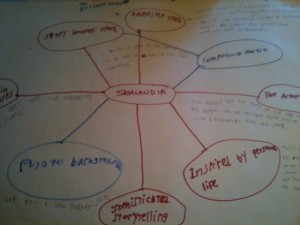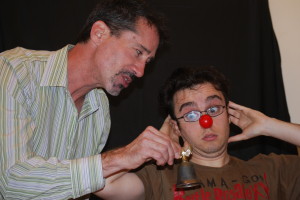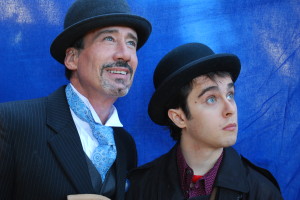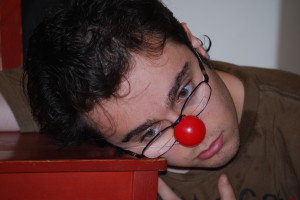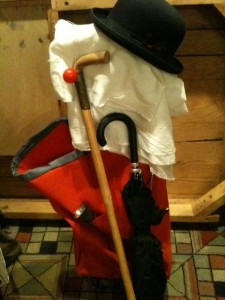 Sam: √ high-top sneakers, √ black pants, √ blue shirt, √ trench coat, √ red nose, √ gas mask, √ bowler hat, √ bow tie, √ wig, √ jacket, √ bottle glasses.
Sam: √ high-top sneakers, √ black pants, √ blue shirt, √ trench coat, √ red nose, √ gas mask, √ bowler hat, √ bow tie, √ wig, √ jacket, √ bottle glasses.
Valier: √ Rolling bag, √ umbrella, bowler hat, √ bell, √ ear muffs, √ oar, √ cane, √ plastic sheet gauze/wrap, √ suit, √ dress shirt, √ tie, √ pocket silks, √ make-up.
Production: √ 3 apple boxes, √ portable screen/stage, √ smoke machine, √ smoke machine fluid, √ projector, √ sound system, √ power chords, √ lights, √ mirror ball, √ rope, √ grip clips, √ programs.
Our intention for Samlandia is to keep things as simple, as minimal, as possible. We want our set to be portable, easy to assemble, and to be able to be packed in a car and able to be adjusted to the size of the venue, where ever we are performing. In preparing for this production, we are putting the emphasis on storytelling and engaging the audience’s imagination to fill in the blanks so that what the audience takes away is the feeling hanging in the air and in their hearts.
The traditional way of making an operatic set is to use painted backgrounds and facades to make the scenery of the opera grand as a means to support the story. People are always trying to find new ways of doing opera. And Samlandia is no exception. With the master design skills of Clay David and the projected multimedia images I (Sam Rubin) am shooting for the backgrounds, our set, though minimal, will be an intrinsic and dynamic, moving element to support the story.
Mozart made operas that included both singing and talking (like The Magic Flute). Samlandia also includes both singing and talking, as well. We’re striving to create a big experience with the least amount of extraneous matter. With respect to how the chaos of life impacts a person with autism, Samlandia seeks to minimize distractive elements as part of the overall experience.

